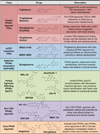Thiazolidinediones and the promise of insulin sensitization in type 2 diabetes
- PMID: 25242225
- PMCID: PMC4192012
- DOI: 10.1016/j.cmet.2014.08.005
Thiazolidinediones and the promise of insulin sensitization in type 2 diabetes
Abstract
Type 2 diabetes is caused by insulin resistance coupled with an inability to produce enough insulin to control blood glucose, and thiazolidinediones (TZDs) are the only current antidiabetic agents that function primarily by increasing insulin sensitivity. However, despite clear benefits in glycemic control, this class of drugs has recently fallen into disuse due to concerns over side effects and adverse events. Here we review the clinical data and attempt to balance the benefits and risks of TZD therapy. We also examine potential mechanisms of action for the beneficial and harmful effects of TZDs, mainly via agonism of the nuclear receptor PPARγ. Based on critical appraisal of both preclinical and clinical studies, we discuss the prospect of harnessing the insulin sensitizing effects of PPARγ for more effective, safe, and potentially personalized treatments of type 2 diabetes.
Copyright © 2014 Elsevier Inc. All rights reserved.
Figures



References
Publication types
MeSH terms
Substances
Grants and funding
LinkOut - more resources
Full Text Sources
Other Literature Sources
Medical
Molecular Biology Databases

